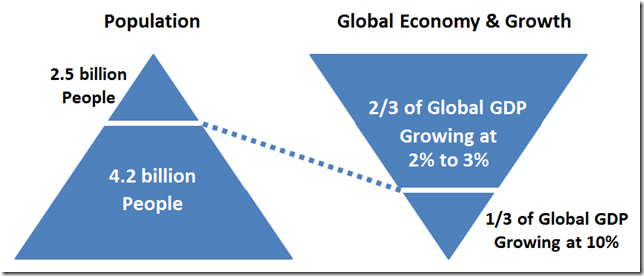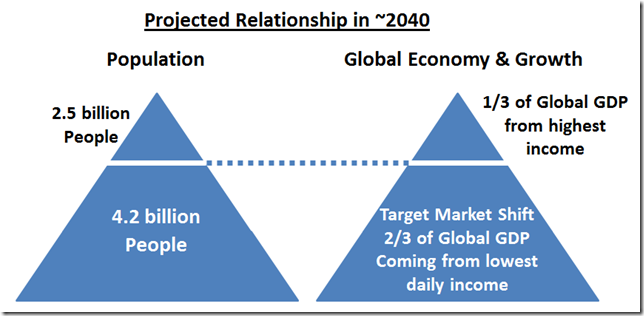 Harvard Business School’s Dr. V. Kastury Rangan asks: “How can businesses create value for the 4.2 billion people who live on less than $5 a day?” Using well understood concepts for value, markets and growth, his challenge is a profound rethink of business in general; and presents the most significant opportunity for disruptive innovation of our time.
Harvard Business School’s Dr. V. Kastury Rangan asks: “How can businesses create value for the 4.2 billion people who live on less than $5 a day?” Using well understood concepts for value, markets and growth, his challenge is a profound rethink of business in general; and presents the most significant opportunity for disruptive innovation of our time.
This is the portion of the world’s population that is growing out of poverty. A creative group made up of of entrepreneurs and visionaries with an unceasing hope for a better future. These people at the base of the global income pyramid do not have water, medicine, health care and generally lack resources the rest of us take for granted. They truly live in commercially underserved markets around the world and present an opportunity for industry for delivering value to those in poverty.
Significance of Disruption in Delivering Value to those in Poverty
Recall that as defined (Clayton Christensen, et. al.,) a disruptive innovation is not a breakthrough innovation that significantly improves an existing product or service to serve current markets and customers. A disruptive innovation is a breakthrough innovation that transforms a product or service that was so complicated and expensive in the past that only a few people could afford it. That disruptive innovation democratizes a new product or service, and enables significantly more people to gain access to an innovation that was previously unavailable. Disruptive innovation enables businesses to pursue completely new markets. Dr. Rangan points us toward that unlikely but highly visible new market.
The Question Reframed
Professor Rangan reframes the question by asking us to consider that there are 6.7 billion people in the world. Two thirds of the world’s population (4.2 billion people) living on less than $5 a day make up one third of the world’s GDP. However, that portion of the global economy is growing at 10% per year.
Contrast that with the top third of the world’s population of 2.5 billion people making up the remainder of the world’s economy which is only growing at 2% to 3% per year.
An Obligation To Stakeholders And The Market
Businesses have an obligation to their stakeholders as the law of percentages on big numbers ensures that focusing on the smaller portion of the population, growing at a slower rate, will be eclipsed by the larger portion of the population growing at 4 to 5 times that rate.
Sourcing Innovation Ideas
Where are the ideas going to come from in order to innovate and serve a market with barely enough income today to purchase food? Who in your organization is thinking globally, and creatively enough to invent this future for your business? Consider that innovation to serve this part of the population pyramid is not product or service innovation alone, but inevitably will include innovation in terms of:
- Go to market strategy
- Distribution and channels
- Business models
- Sustainability models
- And more…
Impossible, No. Inevitable, Yes!
It’s not an impossible concept to grasp. Instead it is inevitable. Consider that others have already found ways to re-engineer traditional approaches that by western thinking alone left this portion of the world behind. Consider how Nobel Laureate, Muhammad Yunus of the Grameen Bank came up with the idea to invent the microcredit industry by thinking differently about credit-worthiness of borrowers living in poverty. Consider how Dr. Venkataswamy founded India’s Aravind Eye Hospitals through a new business model providing vision care to patients regardless of ability to pay – driven only by the notion that everyone deserves to see, and no one who can be helped should remain blind.
This is the kind of creativity thinking of how to serve customers that your company should be thinking about. How should McDonalds Corporation serve this portion of the pyramid? I don’t know, but I’m fairly certain it’s not through expansion of the existing business in its same form. How should Procter and Gamble, Coca Cola, Boeing, Ford, and others provide products to this part of the global market? What are the possibilities? What trends and environmental factors change the game?
What Is Different Today?
Today, mobile phone use has become ubiquitous crossing class and income level in society and across cultures. Connectivity and availability of compute power and cloud-based solutions level the playing field even more, while enabling businesses to extend their reach to serve markets not only across boarders, but also across new tiers in the pyramid. These and many other trends will add to the innovation possibilities.
Moreover, we have a good understanding of how disruption works, and how new innovation can target new markets for quantum growth, or focus on incremental innovation with marginal growth potential to serve existing markets purchasing our products today.
Ponder This Challenge
It’s too easy to ignore this challenge; but as Professor Rangan says, “in 25 to 35 years, if you don’t, your business will be irrelevant or not exist.” Clearly, if you don’t, your business will not be targeting the largest potential market. It will be targeting the diminished market, continuing to decline in size, and potential. Think of the Global Economy and Growth pyramid inverting in the coming 2 to 3 decades. Then, ask yourself or your leadership team the questions below. As a leader, ponder this opportunity to create value, deliver it, and serve this market as the biggest opportunity of our time. Consider how your beliefs, your company’s values, and hope for greatness can be achieved. Then take action.
- How will you shift your company’s management focus off historical data and making the past more efficient, and onto ideas that will invent the future?
- How will you give your people the lens to look into the future and see where and how they can create disruptive innovation?
- How will this shift in target markets affect your business?
- What will you do now to plan for this shift?
- What opportunities will this new growth market present?
- What risks are there in making and timing the transition?
- How will you balance current income target market focus with the new market focus?
- What and how must you innovate for new products and services?
- What and how must you innovate for new business models?
- What and how must you innovate for new product and service delivery models?
- Who in your organization has the creativity to come up with the ideas?
- How will you set vision for the future?
- How will you lead the transition to a new strategy and culture in your organization?
- How will you overcome culture’s change-aversion?
- What will you do to break free of legacy-anchors antibodies that kill innovation?
- How will you enable disruptive thinking in your organization?
Leave a comment and share your thoughts.











